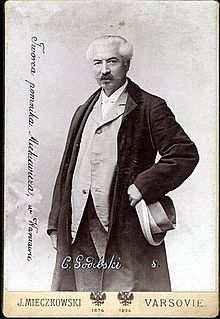Cyprian Godebski may refer to:
Cyprian Godebski may refer to:

Cyprian was a bishop of Carthage and an early Christian writer of Berber descent, many of whose Latin works are extant. He is recognized as a saint in the Western and Eastern churches.

Cyprian Kamil Norwid, a.k.a. Cyprian Konstanty Norwid, was a nationally esteemed Polish poet, dramatist, painter, and sculptor. He was born in the Masovian village of Laskowo-Głuchy near Warsaw. One of his maternal ancestors was the Polish King John III Sobieski.
Novatian was a scholar, priest, and theologian. He is considered by the Catholic Church to have been an antipope between 251 and 258. Some Greek authors give his name as Novatus, who was an African presbyter.

Cyprian Godebski was a Polish poet, novelist and father of writer Franciszek Ksawery. He was an outstanding poet of the so-called "Legions Poetry".

Franciszek Ksawery Godebski was a Polish writer and journalist.
Events from the year 1909 in art.
Józef Zeydlitz was a Polish military commander and a Colonel of the Polish Army.
Cyprian was bishop of Carthage and a notable Early Christian writer and saint.

Adam Mickiewicz Monument in Kraków,, is one of the best known bronze monuments in Poland, and a favourite meeting place at the Main Market Square in the Old Town district of Kraków.
Méry-sur-Cher is a commune in the Cher department in the Centre-Val de Loire region of France.

Cyprian Godebski was a Polish sculptor and from 1870 a professor at the Imperial Academy of Arts in St. Petersburg. He was the grandson of Polish poet and novelist Cyprian Godebski, creator of the "Legions poetry" genre, who had served in Napoleon's Polish Legions.

The Nicolaus Copernicus Monument in Kraków is a notable landmark of Kraków, Poland. It memorializes the astronomer Copernicus, who studied at the Kraków Academy and whose father came from that city, then the capital of Poland.

Adolphe Charles Emmanuel Le Flô was a French Army general and politician.
Dobrogost or Dobrohost is an old Slavic origin given name derived from the elements dobro and gost. Notable people with the name include:

Adam Mickiewicz Monument is a monument dedicated to Adam Mickiewicz at the Krakowskie Przedmieście in the Śródmieście district of Warsaw, Poland. The Neo-Classicist monument was constructed in 1897–1898 by sculptor Cyprian Godebski.

Maciej Masłowski was a Polish art historian.
Edmund Wacław Naganowski, was a Polish publicist and writer also known under pen names E. Działosz, Latarnik and Edmund Sas.

The Cimetière des Champeaux de Montmorency, at Montmorency, Val-d'Oise in Île-de-France, is a cemetery first established in the 17th-century. It has the particularity of being the largest Polish burial place in France, hence its appellation as the "Pantheon of the Polish Emigration". It is located 15 km north of Paris and adjacent to the spa resort of Enghien-les-Bains. That it fell to Montmorency to become the main necropolis of the Polish diaspora in the country is due to two Polish political exiles, who happened to be staying at the nearby spa at the time of their death and were buried in the local cemetery. They were the statesman and poet, Julian Ursyn Niemcewicz, one time Polish envoy to the United Kingdom and Karol Kniaziewicz, politician and brigadier general in Napoleon's Grande Armée. Since their interments in the early part of the 19th-century, a succession of noted exiled Poles found their final resting place in the cemetery. There are over 276 Polish burials, among them the poets Adam Mickiewicz, the national bard, and Cyprian Kamil Norwid, statesman Adam Jerzy Czartoryski, and the diplomat and head of the Polish resistance in France during WWII, Aleksander Kawalkowski. The cemetery has become one of the national symbols of Polish resistance to all forms of oppression, and each Spring, it is the rallying place for Poles living in the Paris area, who go there to commemorate their historical leaders and artists.